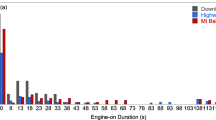Abstract
The objective in present study is to develop a regression analysis model to estimate real-world CO2 emissions of light-duty diesel vehicles considering domestic road conditions. For regression analysis variables, OBD data such as vehicle speed, acceleration, engine speed (rpm), and engine power were used. Regression analysis results were compared with CO2 emissions measured using PEMS on the test routes of the real driving emissions-light duty vehicles (RDE-LDV). In results, the vehicle speed and air/fuel data from the OBD signals maintained a linear relationship with the GPS and exhaust gas flowmeter-based vehicle speed and exhaust flow data. All determination coefficients were ≥0.99, indicating that the OBD data provided by the test vehicle in this study exhibited strong reliability. To investigate the accuracy of the regression equation estimated using the trip variables of the OBD data, the driving variables were substituted into the equation to obtain CO2 estimations and the real CO2 emissions measured using PEMS were compared. A strong linear relationship was observed between the regression equation-based CO2 estimations and real CO2 measurements. The determination coefficient was approximately 0.93, supporting the reliability of the estimation results.
Similar content being viewed by others
Abbreviations
- DOC:
-
Diesel Oxidation Catalyst
- DPF:
-
Diesel Particulate Filter
- GHG:
-
Greenhouse Gas
- LDV:
-
Light-Duty Vehicles
- NEDC:
-
New European Driving Cycle
- OBD:
-
On-board Diagnostics
- PEMS:
-
Portable Emissions Measurement System
- RDE:
-
Real Driving Emissions
- SCR:
-
Selective Catalytic Reduction
- WLTC:
-
World-wide harmonized Light-duty vehicles Test Cycle
References
Barth, M. and Boriboonsomsin, K. (2008). Real-world carbon dioxide impacts of traffic congestion. Transportation Research Record 2058, 1, 163–171.
Cha, J., Lee, J. and Chon, M. S. (2019). Evaluation of real driving emissions for Euro 6 light-duty diesel vehicles equipped with LNT and SCR on domestic sales in Korea. Atmospheric Environment, 196, 133–142.
Choi, H. (2018). The Roadmap of GHG Reduction toward 2030 and the Current State of Ground Vehicles’ GHG Emission in Korea. Auto Journal 40, 2, 23–26.
Dings, J. (2013). Mind the Gap — Why official car fuel economy figures don’t match up to reality. Transport and Environment.
Dings, J. (2015). Mind the Gap 2015 — Closing the chasm between test and real-world car CO2 emissions. Transport and Environment.
European Environment Agency (EEA). (2017). Annual European Union greenhouse gas inventory 1990–2015 and inventory report 2017.
European Commission Regulation (EU). (2017). 2017/1151 of 1 June 2017 supplementing Regulation (EC) No 715/2007. Amending Directive 2007/46/EC, Commission Regulation (EC) No 692/2008 and Commission Regulation (EU) No 1230/2012 and repealing Commission Regulation (EC) No 692/2008.
European Environment Agency (EEA). (2016). Reported CO2 Emissions from New Cars Continue to Fall. EEA Technical Report.
European Parliament and the Council of the European Union. (2009). Regulation (EC) No. 443/2009 of the European Parliament and of the Council of 23 April 2009, setting emission performance standards for new passenger cars as part of the community’s integrated approach to reduce CO2 emissions from light-duty vehicles. Official J. European Union Legislation Series, 140.
Fontaras, G., Zacharof, N. G. and Ciuffo, B. (2017). Fuel consumption and CO2 emissions from passenger cars in Europe-Laboratory versus real-world emissions. Progress in Energy and Combustion Science, 60, 97–131.
Greenhouse Gas Inventory & Research Center of Korea. (2017). National Greenhouse Gas Inventory Report of Korea.
Group PSA, Transport and Environment (T&E), France Nature Environment (FNE) and Bureau Veritas. (2015). Real-world Fuel Economy Measurements: Technical Insights from 400 Tests of Peugeot, Citroen and DS Cars.
Han, J. O., Chae, J. M. and Lee, D. W. (2017). Evaluation of natural gas vehicle fuel consumption using carbon balance method. KSAE Spring Conf. Proc. Jeju, Korea.
Kang, G., Lee, J., Park, J., Cha, J. and Chon, M. S. (2017). Development of Korean RDE routes for on-road emissions measurement of light duty vehicles. Trans. Korean Society of Automotive Engineers 25, 3, 287–296.
Korean Ministry of Environment. (2014). Average Greenhouse Gas and Fuel Economy of Vehicles in 2020. Press Release.
Ligterink, N., Kadijk, G., van Mensch, P., Hausberger, S. and Rexeis, M. (2013). Investigations and real world emission performance of Euro 6 light-duty vehicles. TNO. Delft, Netherlands.
Mellios, G., Hausberger, S., Keller, M., Samaras, C. and Ntziachristos, L. (2011). Parameterisation of fuel consumption and CO2 emissions of passenger cars and light commercial vehicles for modelling purposes. JRC Scientific and Technical Reports, EUR 24927 EN.
National Institute of Environmental Research (NIER) report (2016). Evaluations of Real Driving Emissions-Light Duty Vehicles (RDE-LDV) with PEMS (Portable Emissions Measurement Systems). NIER-SP2016–415.
Rho, K. W. and Shin, D. W. (2012). A study on status analysis and reform of vehicle fuel economy rating system. Korean Energy Economic Review 11, 1, 121–151.
Tietge, U., Díaz, S., Mock, P., German, J., Bandivadekar, A. and Ligterink, N. (2016). From Laboratory to road: A 2016 update of official and ‘real-world’ fuel consumption and CO2 values for passenger cars in Europe. International Council on Clean Transportation (ICCT).
Weiss, M., Bonnel, P., Hummel, R., Manfredi, U., Colombo, R., Lanappe, G., Le Lijour, P. and Sculati, M. (2011). Analyzing on-road emissions of light-duty vehicles with Portable Emission Measurement Systems (PEMS). JRC Scientific and Technical Reports, EUR 24697 EN.
Yang, L., Zhang, S., Wu, Y., Chen, Q., Niu, T., Huang, X., Zhang, S., Zhang, S., Zhou Y. and Hao, J. (2016). Evaluating real-world CO2 and NOX emissions for public transit buses using a remote wireless on-board diagnostic (OBD) approach. Environmental Pollution, 218, 453–462.
Acknowledgement
This research was supported by the National Institute of Environmental Research (NIER), the National Research Foundation of Korea (NRF-2019R1I1A3A01062771), and the Korea Evaluation Institute of Industrial Technology (Keit, 20002762).
Author information
Authors and Affiliations
Corresponding author
Additional information
Publisher’s Note
Springer Nature remains neutral with regard to jurisdictional claims in published maps and institutional affiliations.
Rights and permissions
About this article
Cite this article
Cha, J., Park, J., Lee, H. et al. A Study of Prediction Based on Regression Analysis for Real-World Co2 Emissions with Light-Duty Diesel Vehicles. Int.J Automot. Technol. 22, 569–577 (2021). https://doi.org/10.1007/s12239-021-0053-z
Received:
Revised:
Accepted:
Published:
Issue Date:
DOI: https://doi.org/10.1007/s12239-021-0053-z




